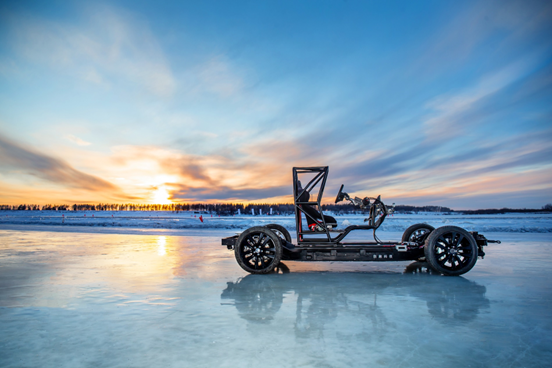Translated Markdown English Text
Author | Zheng Wen
Editor | Zhou Changxian
After a year of silence, YOUPAO Technologies founder and CEO Li Peng has returned with two collaboration projects.
One is the YOUPAO Super VAN, the first whole vehicle product based on the UP Super Chassis, which has completed winter standard testing. The team is the first to land line control technology in the VAN field and will achieve the complete delivery of vehicles by the end of this year. Domestic and foreign orders have already been received.
The second is for off-road scenes, with off-road E-club, which has 17 million off-road enthusiasts, partnered to create a series of off-road cars and exclusive experiences based on the newly released whole line control UP Super Chassis.
This is exciting news for the skateboard chassis track.
In the past year, overseas the “skateboard chassis” was brought into action by the American car-making new force, Rivian, which was continuously under-capacity while its market value plummeted. Meanwhile, domestic companies seem to have taken a different path, with all kinds of startups, Tier 1s, and OEMs throwing themselves into it. YOUPAO has also received collaboration projects, with speedy technological progress.
“Recently, Chat GPT has once again pushed AI to new heights. In the industrial society of the 20th century, people are becoming more and more like machines. In the post-industrial society of the 21st century, machines will become more and more like humans.” Li Peng expressed passionately at the press conference that this was also the starting point of the research and development of the whole line control UP Super Chassis, “making cars more like people, becoming car robots.”
Long ago, Li Peng abstracted two core driving factors that caused changes in the car industry. One is the technological attribute of the car, and the other is the consumer goods attribute of the car.
In his view, cars have transitioned from electromechanical integrated mechanical products to technological attribute products, with software costs becoming more and more expensive. This means that when cars are driven by software costs, standardized hardware solutions begin to generate enormous advantages.
There is no doubt that skateboard chassis companies are the result of the recombination of the industrial chain in the new era of change. Backed by a complete global automotive supply chain system, YOUPAO, which is the first company in China to volume produce a fully monitored skateboard chassis, aims to break the spell of the industry and run out onto a new skateboard chassis track.
Clear Technical Path
Academician Ouyang Minggao once listed skateboard chassis as one of two trends for future new energy technology.
In his view, the advantage of skateboard chassis is that the chassis remains unchanged and can be easily turned into various models. This is a result of many years of technological evolution and represents the trend of technological development.The technological roadmap is undoubtedly reasonable, which is evidenced by the layout of many mainstream car manufacturers and Tier 1 companies in this field. For example, major automakers such as Great Wall Motors, Chery Automobile, and BAIC Blue Valley have all launched relevant plans; Ningde Times, which is in the middle of the industrial chain, has disclosed related layout information several times; and Tier 1 companies such as Top Group and Schaeffler have made breakthroughs in online control technology.
It is worth mentioning Bosch. According to Chen Yudong, President of Bosch China, six years ago, Bosch demonstrated technology related to skateboard chassis and wanted to acquire a startup company in this field, but for various reasons, it did not succeed. In September 2021, Bosch changed its strategy and participated in the Pre-A+ round of financing of Youpao Technology through its subsidiary Bosch Power Capital, and the two parties launched deep cooperation in technology research and development.
In summary, the skateboard chassis consists of mechanical structural components and electronic structural components, which can be divided into three parts: front axle, middle axle, and rear axle, with the front axle including front suspension, subframe, motor, and steering gear, the middle axle including battery, anti-collision structure, and thermal management system, and the rear axle including rear suspension, subframe, and motor.
Skateboard chassis companies integrate the three main components, including the powertrain, suspension, braking, steering, battery, electric drive system, and suspension, into a skateboard-like chassis for integrated design.
Cars are simplified into two parts: chassis and body. The skateboard chassis undertakes two major functions: the chassis domain and the intelligent driving domain. It can be said that from the bottom-up logic of car R&D, it has already been completely changed.
Based on Youpao Technology’s products, there are four core technologies: fully wired control chassis, pluggable ring network electronic and electrical architecture (CCCA), CTC battery system, and highly integrated thermal management system. Regarding CTC and thermal management systems, our previous articles have detailed explanations. This article mainly explains wired control and pluggable ring network electronic and electrical architecture.# UP CCCA and UP VMC-based YOUPAO Ultra-Performance Chassis: An Integrated Automotive OS for Intelligent EVs
YOUPAO Ultra-Performance (UP) chassis is built on the UP CCCA (Communication, Calculation and Control Architecture) and UP VMC (Integrated Motion Field Control) technologies, striving to become an integrated “software and hardware” automotive operating system for intelligent EVs.
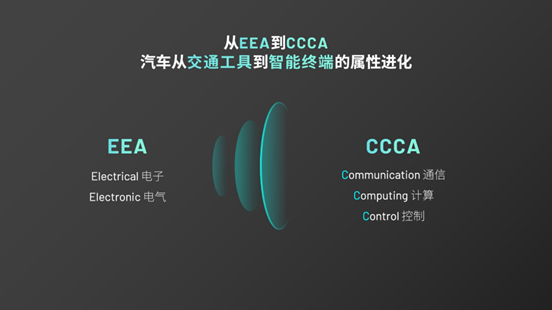
Compared with the widely-used EEA architecture, YOUPAO’s CCCA architecture focuses more on data transmission, calculation, and whole-vehicle motion control. Moving from EEA to CCCA represents the iteration of car attributes from transportation tools to intelligent terminals.
Unlike traditional EEA that focuses on “functionality,” CCCA lays emphasis on information communication, calculation, and control of vehicle displacement. This is a step further than the CCA (Communication/Computing Architecture) architecture proposed by Huawei, which began with ICT technology.
In the era of intelligent EVs, software endows the automotive chassis with a completely new definition. The application of electronic signals replaces mechanical line-control technology and is the key force to realize digitization of the automotive chassis.
Line-control steering, line-control braking, line-control driving, and line-control suspension, all of which were mechanically connected, are now connected by electronic signals and modularized in control, freeing from the constraints of mechanical control.
Coordinating the above-mentioned line-control actuators is the technical core of YOUPAO UP VMC.
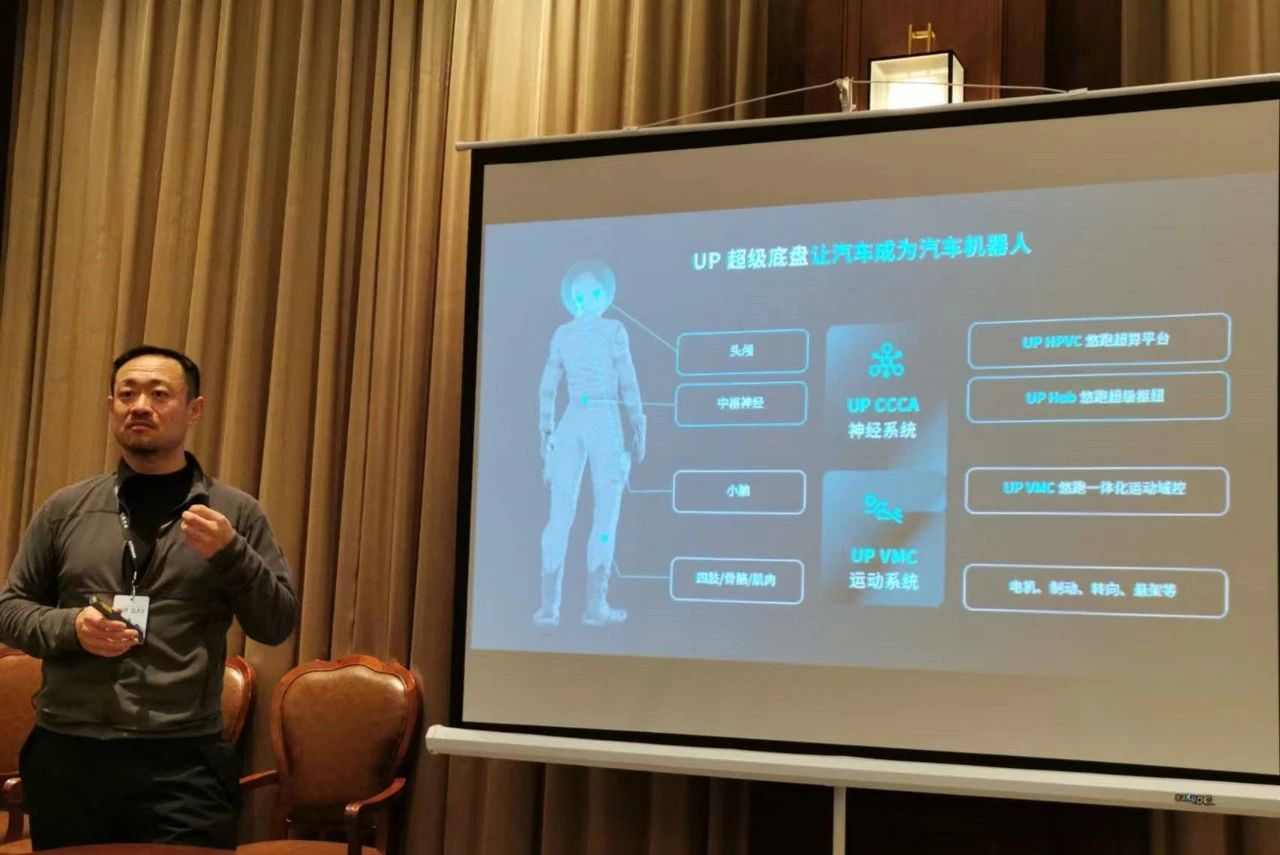
Li Peng believes that if the automotive frame and load-bearing system can be compared to human bones, and various motors, brakes, steering gears, and suspensions in the chassis can be compared to muscles (i.e., motion systems), then the CCCA, which involves the communication, calculation and control of architecture, can be seen as the nervous system, including the cerebellum and central nervous systems. Finally, the UP automotive supercomputing platform that functions as the container of the brain is like the skull.
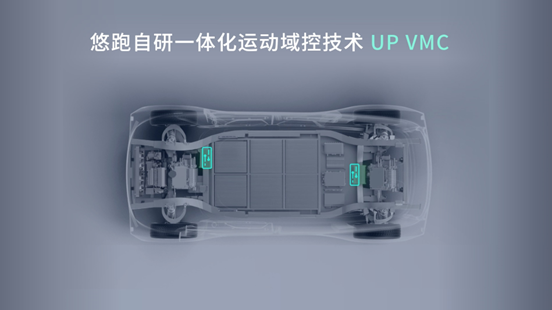 Thanks to Yopark’s independently-developed unified motion domain control technology (UP VMC) and full-line control, the dynamics, braking, steering, and suspension of vehicles, i.e., the X, Y, and Z axes, have all been digitized, enabling vehicles to break free from the constraints of traditional physical structures. Yopark’s self-developed UP VMC has achieved integrated control of chassis movement through line control of braking, steering, and suspension, which can be uniformly configured, developed, and operated.
Thanks to Yopark’s independently-developed unified motion domain control technology (UP VMC) and full-line control, the dynamics, braking, steering, and suspension of vehicles, i.e., the X, Y, and Z axes, have all been digitized, enabling vehicles to break free from the constraints of traditional physical structures. Yopark’s self-developed UP VMC has achieved integrated control of chassis movement through line control of braking, steering, and suspension, which can be uniformly configured, developed, and operated.
Under line control technology, vehicle dynamic performance is relatively easy to adjust by adjusting different parameters, greatly reducing R&D time. For example, with VMC, a drifting posture of a car can be achieved by giving an appropriate beta angle to all four wheels using the car’s dynamic model parameters, which used to require rigorous practice of stunt actors.
As the vehicle is not limited by mechanical structures, Yopark’s UP Super Chassis can theoretically achieve any desired turning intent and the driving position is flexible, which can meet the space layout requirements of different vehicle models. For example, different driving experiences can be obtained by changing the steering ratio in different modes. During daily driving, it provides a comfortable experience of high-speed stability and low-speed flexibility, while it can achieve precise and sensitive handling like an F1 racing car on the racetrack.
It was revealed by Li Peng that our electrically-controlled active hydraulic suspension system will soon be installed in vehicles. It can actively control the posture of the car by utilizing hydraulic components according to the suspension height and acceleration.
After adopting the active suspension system, the car’s control of rolling, pitching, yawing, and body is more rapid and precise, improving the stability of high-speed driving and turning, and reducing body roll. The front end of the car dips less during braking, and pitching is reduced during acceleration and sudden starts. Even on rough roads, it can effectively suppress body bounce, enhancing the tire’s grip on the ground.
It is understood that the upcoming BYD Cloud-Chariot system is an intelligent vehicle body control system that integrates stereo fusion control of vehicle lateral, longitudinal, and vertical directions. As the name implies, it shares similarities with many features that the Yopark UP Super Chassis has achieved.## Uncertainty of Business Model
In 2002, General Motors released a concept car, the Hy-wire, which was revolutionary with its “drive-by-wire chassis + hydrogen power”. The body and chassis were separate, and the almost flat “skateboard-shaped” chassis adopted wire-controlled technology originally developed for the aviation industry, abandoning traditional hydraulic steering, braking and other structures.
If the hydrogen tank is replaced with a battery pack, its battery system, thermal management system, and motor system layout are consistent with the current electric vehicle’s “skateboard chassis”.
In November 2020, the American start-up company, Rivian, created an industry record with a high opening price on its first day of listing, and its intraday gains once exceeded 53%, with a market value exceeding 100 billion U.S. dollars, surpassing traditional automakers such as General Motors, Ford, and Honda in one fell swoop. The company’s main business is the skateboard chassis, and it has produced a mass-produced version.
However, the frenzy of the technological path cannot cover up some fundamental problems.
Essentially, the skateboard chassis still has a strong “shared” attribute. If standardized skateboard chassis can be mass-produced, it can reduce the waste of resources in the chassis aspect, which is indeed very positive for the industry.
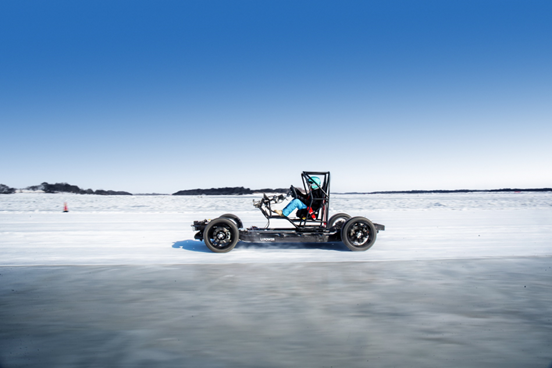
The obvious advantage of the skateboard chassis scheme is that the cost is reduced, and the development cycle is shortened, which is particularly advantageous for cross-border technology companies who want to travel light. The capital expenditure required for developing a high-standard chassis system is in the billion-level category, and it puts a lot of pressure on enterprises. Direct procurement of skateboard chassis can greatly reduce the cost pressure in this part and also shorten the development cycle.
Wang Huadong, a partner of Matrix China, once said that “Youpu Technology’s development of a super chassis can shorten the new car development cycle to within 12 months and lower the capital threshold to within 100 million dollars,” greatly empowering emerging car companies to focus on higher-value-added brand building, user services and data closed-loop processes.”
Sergio Marchionne, former CEO of FCA, once said that compared with other industries, the investment automakers make in research and development accounts for too high a proportion of the company’s value. Their average R&D expenses once every 4.1 years equal their own enterprise value, while the average level of the entire industry is about 20 years.
According to his calculations, 45% to 50% of the enormous automobile R&D costs are spent on areas that consumers cannot perceive, and every competitor is spending the same money to do similar things. Marchionne pointed out the serious problems faced by the entire industry. Many enterprises are making a lot of repetitive investments, which is what we commonly call “reinventing the wheel.”The ideal is ambitious, but the reality may be skinny.
Objectively speaking, it’s not so easy to achieve the standardized mass production of the sliding chassis in the passenger car field. If the current automotive platform architecture mainly considers the generalization of mechanical parts and interface standardization, the general chassis like a skateboard chassis is not considered at this level.
Take Toyota’s current TNGA architecture as an example, by turning the chassis, powertrain, and basic components into standardized and modularized products, the percentage of universal parts in TNGA models can even reach 70% to 80%, while the initial universal ratio of the architecture is only 20% to 30%.
For electric car skateboard chassis, the focus is on the integration of electronic and electrical architecture and interface standardization, as well as modularization and classification of software and hardware decoupling. These are the current research and development priorities. The recently released ORA Punk Cat electric car platform by WM Motor mentions that battery modules can communicate wirelessly. Huawei is also working on wireless electronic architecture to reduce the “uncontrolled wire harness cost black hole” of car manufacturing.
Traditional automakers may not be willing to accept such a transformation. The core R&D system of the previous automakers, which includes self-developed chassis, body, etc., and the appearance of skateboard chassis, has broken the existing ecological chain. Even if the modular design of the skateboard chassis is accepted by automakers, they are willing to invest heavily in it.
Even if the importance coefficient of electric car chassis is reduced compared to traditional fuel vehicles, this part is not something that automakers are willing to give up. It integrates modules such as motor, battery, intelligent driving chips, steering, and braking, and the BOM (bill of materials) ratio may reach 60% to 70%. Automakers with strength will not give up outsourcing such a high proportion of modules.
In addition, another issue that automakers may consider is that it may be a difficult and unrewarding task to find a third party to do the skateboard chassis in the case of overturning the original supply chain. Because the business changes in this part of the industrial chain have not brought incremental value and are not new business growth points.
At present, the skateboard chassis is still mainly used in low to medium speed scenarios, such as some specialized and commercial vehicle markets with fragmented and customized characteristics. In the long run, the skateboard chassis still has a long way to go.
As the old saying goes, it is difficult for automakers to give up the mastery of these core technologies. “Cannot hand over the soul to others” is almost the common voice of mainstream car companies. This is the difficulty for third-party skateboard chassis companies in business expansion.Perhaps being acquired by a certain OEM eventually could be a good outcome. In other words, although the technical path is rational, many companies may choose to vote with their feet for their own interests.
Regarding this, Li Peng’s idea is very pragmatic. “We don’t need to convince everyone, just a little bit at a time. The premise is that our products must create commercial value.”
He believes that to this day, most of the relevant technologies in chassis development are owned by international major manufacturers, and the barriers to independent chassis development are high and thick. Just like the iceberg beneath the sea level, it is easier to be ignored, but it provides support for the entire industry.
Li Peng believes that bottom-up innovation, such as the skateboard chassis, is hidden beneath the sea level, and the YOUPA all-line controlled UP super chassis will help scene-based car makers to build cars more simply and efficiently.
For example, thanks to the standardized chassis actuator and intelligent standardized interface, from the user side, it is compatible with different autonomous driving company schemes, and it becomes possible to auto-drive App, which means that users can choose different autonomous driving algorithm companies on the same car.
For OEMs, it can also effectively reduce a large amount of software and hardware adaptation work, allowing them and intelligent driving solution providers to focus on more valuable perception and algorithm layers, reducing manpower input and development cycle.
Regarding YOUPA’s positioning on the industrial value chain, Chen Yudong believes that YOUPA is equivalent to Tier 0.5. Therefore, Bosch is not only an investor in YOUPA, but also a supplier. For example, Bosch’s line control technology can be used for YOUPA.
“China missed the opportunity to develop an operating system for smart phones. Now we have the opportunity to do an operating system for smart cars.” For the future of YOUPA, Li Peng clearly has bigger ideas.
He said that YOUPA is willing to work with excellent companies in the Chinese automobile industry chain to innovate under the iceberg and jointly promote the development of the intelligent electric vehicle industry.
This article is a translation by ChatGPT of a Chinese report from 42HOW. If you have any questions about it, please email bd@42how.com.
